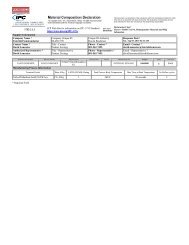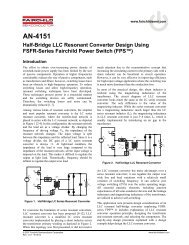AN-3008 RC Snubber Networks for Thyristor Power Control and ...
AN-3008 RC Snubber Networks for Thyristor Power Control and ...
AN-3008 RC Snubber Networks for Thyristor Power Control and ...
Create successful ePaper yourself
Turn your PDF publications into a flip-book with our unique Google optimized e-Paper software.
APPLICATION NOTE<br />
<strong>AN</strong>-<strong>3008</strong><br />
the values required <strong>for</strong> the model are not easily obtained<br />
except by testing. There<strong>for</strong>e, reliability should be verified in<br />
the actual application circuit.<br />
Table 1 shows suggested minimum resistor values estimated<br />
(Appendix A) by testing a 20 piece sample from the four<br />
different TRIAC die sizes.<br />
Table 1. Minimum Non-inductive <strong>Snubber</strong> Resistor <strong>for</strong><br />
Four Quadrant Triggering.<br />
Peak V C<br />
TRIAC Type Volts<br />
Non-Sensitive 200<br />
Gate<br />
300<br />
(I GT > 10mA) 400<br />
8 to 40 A (RMS) 600<br />
800<br />
R S Ohms<br />
3.3<br />
6.8<br />
11<br />
39<br />
51<br />
dl<br />
dt<br />
A/µS<br />
170<br />
250<br />
308<br />
400<br />
400<br />
dl<br />
Reducing<br />
dt<br />
dI<br />
TRIAC ---- can be improved by avoiding quadrant 4<br />
dt<br />
triggering. Most optocoupler circuits operate the TRIAC in<br />
quadrants 1 <strong>and</strong> 3. Integrated circuit drivers use quadrants 2<br />
<strong>and</strong> 3. Zero crossing trigger devices are helpful because they<br />
prohibit triggering when the voltage is high.<br />
Driving the gate with a high amplitude fast rise pulse<br />
dI<br />
increases ---- capability. The gate ratings section defines the<br />
dt<br />
maximum allowed current.<br />
dI<br />
Inductance in series with the snubber capacitor reduces ---- .<br />
dt<br />
It should not be more than five percent of the load inductance<br />
dV<br />
to prevent degradation of the snubber’s ------ suppression<br />
dt<br />
capability. Wirewound snubber resistors sometimes serve<br />
this purpose. Alternatively, a separate inductor can be added<br />
in series with the snubber capacitor. It can be small because<br />
it does not need to carry the load current. For example, 18<br />
turns of AWG No. 20 wire on a T50-3 (1/2 inch) powdered<br />
iron core creates a non-saturating 6.0 µH inductor.<br />
A 10 ohm, 0.33 µF snubber charged to 650 volts resulted in a<br />
dI<br />
1000 A/µs ---- . Replacement of the non-inductive snubber<br />
dt<br />
resistor with a 20 watt wirewound unit lowered the rate of<br />
rise to a non-destructive 170 A/µs at 800 V. The inductor<br />
gave an 80 A/µs rise at 800 V with the non-inductive resistor.<br />
The <strong>Snubber</strong> Capacitor<br />
A damping factor of 0.3 minimizes the size of the snubber<br />
dV<br />
capacitor <strong>for</strong> a given value of ------ . This reduces the cost <strong>and</strong><br />
dt<br />
physical dimensions of the capacitor. However, it raises<br />
voltage causing a counter balancing cost increase.<br />
<strong>Snubber</strong> operation relies on the charging of the snubber<br />
capacitor. Turn-off snubbers need a minimum conduction<br />
angle long enough to discharge the capacitor. It should be at<br />
least several time constants (R S C S ).<br />
Stored Energy<br />
Inductive Switching Transients<br />
1 2<br />
E -- L I<br />
2 O Watt-seconds or Joules<br />
I O = current in Amperes flowing in the inductor at t = 0.<br />
=<br />
R<br />
V PK<br />
C<br />
Resonant charging cannot boost the supply voltage at turnoff<br />
by more than 2. If there is an initial current flowing in the<br />
load inductance at turn-off, much higher voltages are possible.<br />
Energy storage is negligible when a TRIAC turns off<br />
because of its low holding or recovery current.<br />
The presence of an additional switch such as a relay, thermostat<br />
or breaker allows the interruption of load current <strong>and</strong> the<br />
generation of high spike voltages at switch opening. The<br />
energy in the inductance transfers into the circuit capacitance<br />
<strong>and</strong> determines the peak voltage (Figure 15).<br />
dV<br />
dt<br />
L<br />
I<br />
= V PK = I<br />
C<br />
L<br />
C<br />
(a.) Protected Circuit<br />
I<br />
OPTIONAL<br />
FAST<br />
SLOW<br />
(b.) Unprotected Circuit<br />
Figure 15. Interrupting Inductive Load Current<br />
Capacitor Discharge<br />
⎛ 1<br />
The energy stored in the snubber capacitor E C = --CV 2 ⎞<br />
⎝ 2 ⎠<br />
transfers to the snubber resistor <strong>and</strong> thyristor every time it<br />
turns on. The power loss is proportional to frequency<br />
(P AV = 120 E C @ 60 H Z ).<br />
Current Diversion<br />
The current flowing in the load inductor cannot change<br />
instantly. This current diverts through the snubber resistor<br />
dV<br />
causing a spike of theoretically infinite ------ with magnitude<br />
dt<br />
equal to (I RRM R) or (I H R).<br />
Load Phase Angle<br />
Highly inductive loads cause increased voltage <strong>and</strong> ⎛dV<br />
------ ⎞<br />
⎝<br />
at<br />
dt ⎠c<br />
turn-off. However, they help to protect the thyristor from<br />
transients <strong>and</strong> ⎛dV<br />
------ ⎞<br />
⎝<br />
. The load serves as the snubber<br />
dt ⎠<br />
s<br />
REV. 4.01 6/24/02 7







